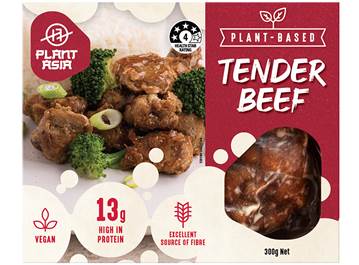
An example of plant-based protein products being sold in Australian supermarkets.
ALTERNATIVE proteins have attracted positive media coverage in recent years, helped in part by a number of industry-generated reports that have promoted plant and cell-based products as more sustainable and healthier alternatives to conventionally farmed meat and milk.
However, a biotechnology professor who describes himself as a supporter of both alternative and conventionally produced proteins is calling for greater scrutiny to be applied by media to the science underpinning many alternative protein industry claims.
 Professor Paul Wood AO said that from his perspective several reports which have helped the alternative protein sector to generate favourable media coverage for its products in recent years rely on misleading information that unfairly and inaccurately denigrates conventional meat and dairy production in order to attract consumer and investor support for plant and cell-based replacements.
Professor Paul Wood AO said that from his perspective several reports which have helped the alternative protein sector to generate favourable media coverage for its products in recent years rely on misleading information that unfairly and inaccurately denigrates conventional meat and dairy production in order to attract consumer and investor support for plant and cell-based replacements.
Professor Paul Wood AO is an adjunct professor in biotechnology at Monash University and Fellow of the Australian Academy of Technological Sciences and Engineering.
In the lead up to a recently launched Senate Inquiry into definitions of meat and other animal products, he offers a unique perspective on the issue as an independent biotechnologist with experience across the food protein spectrum, spanning both the conventional and non-conventional protein production sectors.
He sits on the boards of Dairy Australia and the Global Alliance for Livestock Veterinary Medicines.
He also chairs an insect protein start-up company and is a member of the advisory board of Cellular Agriculture Australia.
In 2018 he was awarded an Order of Australia medal for his distinguished service to science and global human and animal health through biopharmaceutical research and technological advances.
Prof Wood describes himself as a supporter of alternative proteins, and says there is room in the market for both current and future protein products. He believes both will be essential to feed the growing requirements of a rapidly expanding global population.
However, he said media articles favourably reporting alternative protein industry reports without applying scrutiny to the science underpinning their claims have compelled him to speak out and draw attention to claims being made by the industry.
He believes reports released in recent years to promote alternative proteins from groups such as the US-based Rethink X and Australian-based Food Frontier have quoted selectively from sources to draw conclusions that present a negative view of livestock production systems, but which don’t reflect the actual data or conclusions of the papers they reference. (In response to Prof Wood’s points raised in this article Food Frontier has provided a statement saying the report is no longer in circulation on its website and emphasising its view that there is a need for both conventonally produced and alternative proteins and significant opportunities for Australian agriculture as a result – see full statement from Food Frontier below).
Some examples Prof Wood highlights include:
* Food Frontier’s “Meat Re-Imagined” report published in 2019 cites UN Food and Agriculture Organisation information stating that livestock production requires about 80 percent of the world’s agricultural land, produces just 18 percent of the world’s calories, uses a third of global croplands to grow feed for farm animals, and uses more than a quarter of the planet’s habitable land.
However, Prof Wood points out that the Food Frontier report did not include a range of other important facts from the same source that present a far more positive view of livestock agriculture, including:
* 86 percent of livestock feed is not suitable for human consumption. Livestock rely primarily on forages, crop residues and by-products that are not edible to humans;
* Certain production systems contribute directly to global food security, as they produce more highly valuable nutrients for humans, such as proteins, than they consume;
* Animal food sources make a vital contribution to global nutrition and are an excellent source of macro- and micronutrients;
* Livestock products make up 34 percent of global protein consumption and provide essential micro-nutrients, such as vitamin B12, iron and calcium.
* Livestock use large areas of pastures where nothing else could be produced;
* Animals also add to agricultural production through manure production and drought power;
* Keeping livestock provides a secure source of income for over 500 million poor people in many in rural areas.
* While some often-cited studies put the consumption of grain needed to raise 1kg of beef between 6kg and 20kg, contrary to these high estimates, UN FAO reports show an average of only 3 kg of cereals are needed to produce 1 kg of meat at the global level.
* There are also differences between production systems and species. For example, in many regions because they rely on grazing and forages, cattle need only 0.6 kg of protein from edible feed to produce 1 kg of protein in milk and meat, which is of higher nutritional quality.
Cattle thus contribute directly to global food security, Prof Wood said.
* The Meat Re-imagined report states that intensive animal agriculture production presents significant public health risks through issues such as rising antibiotic resistance and the breeding of new zoonotic diseases.
Prof Wood said the paper cites an article that is an opinion piece and not one that presents primary data to arrive at these conclusions.
“It is interesting that they don’t actually mention that the avian species involved in the flu story include many wild species such as migratory ducks.
“They also do not mention that the use of antibiotics in animal feed has been phased out in most countries and that less than 5 percent of the antibiotic resistant human infections are related to pathogens from animals.”
Nor did the report acknowledge that the majority of zoonotic disease issues originate from wildlife, not livestock.
Oxford study showed
The “Meat Re-Imagined” report further states that a February 2019 University of Oxford study comparing the climatic impacts of cell-based meat versus conventional beef cattle systems showed benefits “were strongly in favour of cell-based meat for the first 100 years”.
However, according to Prof Wood, the study’s conclusion was less supportive of cell-based meat in the long term.
‘We conclude that cultured meat is not prima facie climatically superior to cattle’
He said the report states that under continuous high global consumption, while cultured meat results in less warming than cattle initially, the gap narrows in the long term and “in some cases cattle production causes far less warming, as CH4 emissions do not accumulate, unlike CO2”.
It noted that although cattle systems generally result in greater peak warming than cultured meat, the warming effect declines and stabilises under the new emission rates of cattle systems, while the CO2 based warming from cultured meat persists and accumulates even under reduced consumption, again overtaking cattle production in some scenarios.
“We conclude that cultured meat is not prima facie climatically superior to cattle; its relative impact instead depends on the availability of decarbonized energy generation and the specific production systems that are realized,” the study stated.
Plant-based value projections “highly speculative”
Prof Wood, who has extensvie experience working in precision fermentation in both the academic and commercial sector, described a further report prepared by Deloitte for Food Frontier and released earlier this year, titled Meat the Alternative, as “very speculative” in its estimate of the size of the potential market for alternative proteins.
The report put the size of the plant-based meat market in Australia at $150 million in 2018/19, and predicted it will generate an additional $2.9 billion in domestic sales by 2030.
No detail on the modelling supporting that prediction is provided in the report, but Prof Wood says that to achieve that target the industry would have to achieve a compound annual growth rate (CAGR) of 43 percent per annum for 10 consecutive years.
“It would be interesting to know if any food group has ever had CAGR of this magnitude in Australia,” he said.
Projections of price parity ignore many major costs of manufacture
Prof Wood also questioned the lack of scrutiny evident in media coverage of the Rethink X’ “Rethinking Food and Agriculture 2020-2030” report produced in 2019 which contained several radical claims, including that by 2030 the US dairy and cattle industry “will have collapsed”.
This prediction drew on conclusions that the cost of alternative proteins would be five times cheaper than animal proteins by 2030, and 10 times cheaper by 2035, based on the view that advances in precision fermentation technology will allow for a totally new model of food production.
To anyone shocked by these predictions and perhaps even in fear for the future of their livelihoods, Prof Wood’s message is simple: “Let me assure them that they need not worry.”
To anyone shocked by these predictions and perhaps even in fear for the future of their livelihoods, Prof Wood’s message is simple: “Let me assure them that they need not worry.”
An assumption in the Rethink X report was that the cost of production of recombinant proteins will be reduced by over a hundred-fold. The sole source of technical information for these predictions was The Good Food Institute (GFI), which is a non-profit organisation established in 2016 to promote plant-based meat, dairy, and eggs and cultivated meat as alternatives to conventional animal products.
Prof Wood said that from a scientific perspective the assumptions contained in the report “are difficult to justify and would not be supported by professionals involved in commercial protein fermentation”.
He said the report assumes a 1600-fold reduction can be achieved in the cost of producing cell cultured meat, which in his view is naïve and ignores many major costs of manufacture.
Even without doing a full facility costing we are talking about hundreds of millions to build and validate a large-scale facility. Also, no mention is made of the fact that all of these procedures will need to be aseptic to avoid bacterial or fungal contamination of the cell-cultures.”
He said the report also makes the mistake of assuming the industry can use lower standards of production for a technology that requires highly skilled staff, rigorous attention to protocols and exists in a highly regulated environment, in contrast to what regulatory agencies will demand for these products.
Prof Wood said that to his knowledge, he is not aware of any company currently planning to use precision fermentation to produce molecular meat or any research group who have developed this technology.
Professor Wood said he believes that for a more balanced and accurate guide on the future of the protein market in Australia people should refer to the Australian Farm Institute’s February 2020 publication “The changing landscape of protein production”.
“The AFI report is more balance and show the significant differences in the quality of proteins from various sources,” Prof Wood said.
“They also conclude that alternative proteins will not be a major threat to Australian animal agriculture.
“While the growth rates for uptake of some of these alternative protein products look impressive, they are coming from a very low base and their market share is still very small.
“Despite the hype the investment received by alternative protein companies is still significantly less than other food-related innovation industries.”
Food Frontier: “Both industries can not only co-exist but thrive in Australia”
In response to the issues raised by Prof Wood, Food Frontier CEO, Thomas King provided a statment to Beef Central pointing out that its “Meat Re-imagined” report which was published 2.5 years ago is no longer publicly available due to being out of date.
 He added that the report was peer-reviewed by a panel of academics and industry experts, including esteemed Australian agricultural specialists, and all of its reports have been met with praise from a wide range of industry professionals, policymakers, researchers and educators, as well as university academics and professors including from Monash University.
He added that the report was peer-reviewed by a panel of academics and industry experts, including esteemed Australian agricultural specialists, and all of its reports have been met with praise from a wide range of industry professionals, policymakers, researchers and educators, as well as university academics and professors including from Monash University.
With the global population tipped to increase to 10 billion by 2050, he said Food Frontier’s position is that both industries can not only co-exist in Australia, but they can thrive together, and warned that Australia cannot afford to turn its back on new industries that will create significant economic benefit and jobs over the coming years.
See full statement from Food Frontier below:
“Dr Wood provided feedback to Food Frontier regarding the ‘Meat Reimagined’ report, which was released two and a half years ago and is no longer publicly available due to being out-of-date. His feedback was taken on board at the time.
“We note that this is the only critical feedback Food Frontier has ever received regarding one of our publications. Like many of our reports, this one was peer-reviewed by a panel of academics and industry experts, including esteemed Australian agricultural specialists.
“All of Food Frontier’s publications to-date – developed by our team of agriculture, food safety, FMCG and research professionals – have been met with praise from a wide range of industry professionals, policymakers, researchers and educators, as well as university academics and professors including from Monash University.
“Dr Wood has not previously raised any concerns regarding Food Frontier’s 2019 State of the Industry report, ‘Meat the Alternative’, nor has he requested the modelling it contains produced by Deloitte.
“The global population is tipped to increase to 10 billion by 2050. Overwhelming evidence indicates that both established and emerging protein sectors will be required to meet this future demand. Food Frontier agrees that both industries can not only co-exist in Australia, but they can thrive together, and we welcome an evidence-based discussion that helps us achieve this goal.
“Australia cannot afford to turn its back on new industries that will create significant economic benefit and jobs over the coming years, particularly for our agricultural industry in rural Australia.
“We always welcome feedback and encourage open, evidence-based discussion.”

Also eating 3kg of cereals would never give such a complex and dense range of nutrients as 1KG of beef/meat would. It’s like comparing the nutritional benefits of eating 300kcals of icecream to eating 300kcals of meat. Your body utilises the protein to a much fuller extent.
Interesting 😊
Lab Slime pushers use lies, dishonesty and deception to sell their inferior products. Truth in labeling is needed.